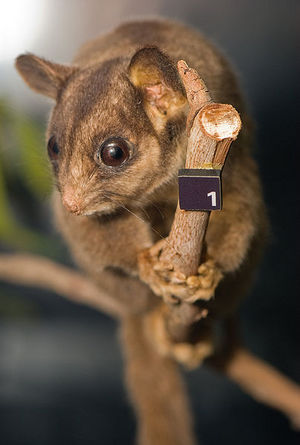The leadbeater’s possum was thought to be extinct for fifty two years until it was rediscovered in the year of 1961.
Physical Characteristics
The leadbeater’s possum is six to seven inches long and weighs only three to six ounces. It’s tail is about as long as its body, sometimes longer, and measures six to eight inches. Its fur is gray on the back and has one dark stripe down the center from the head to the tail. Its underside is off white.
Behavioral Characteristics
The leadbeater’s possum lives in a group social unit. Their groups are called colonies and may have up to eight members. The eight members will be comprised of a single, senior breeding pair and its offspring. Most of the offspring will be males. Unlike many species of animal, it is the females and not the males who defend the group’s territory. It is speedy and elusive, living in the trees. The scientific term for tree dwellers is arboreal. It is also nocturnal, sleeping during the day and becoming active during the night.
Life Cycle
The leadbeater’s possum breads almost all year. The only time they don’t bread is during the months of January and February. Most births occur during May, June, October and November. The average litter season is one or two young. They are weaned usually by about three months of age. The leadbeater’s possum does not become sexually mature until they are two years old.
Diet
The leadbeater’s possum is omnivorous. Its typical diet consists mainly of small invertebrates and tree saps (for example, gum, sap and nectar).
Habitat
The leadbeater’s possum only lives in a very small area in south-east Australia in the central highlands, victoria region.
Conservation Status
The leadbeater’s possum is classified as endangered by the IUCN (International Union of Conservation of Nature and Natural Resources) red list of threatened species. The reasons the IUCN gives for this classification is that its range measures less then five thousand square kilometers, its range is very fragmented and both of these factors are continuing to worsen. The main threats to this species survival is the loss of habitat. It normally uses old trees for shelter and this are falling down and new, suitable shelters are slow in developing. Global warming could also have a detrimental effect on the leadbeater’s possum because it is very susceptible to climate changes.
References:
Animal: The Definitive Visual Guide to the World’s Wildlife by, David Burnie and Don E. Wilson
http://www.iucnredlist.org/details/9564/0
http://www.animalinfo.org/species/gymnlead.htm
